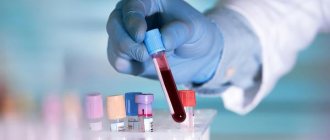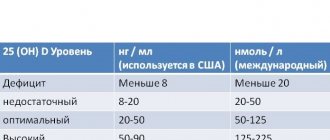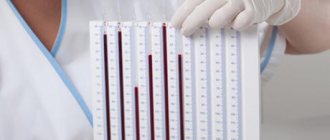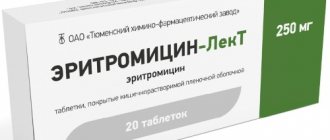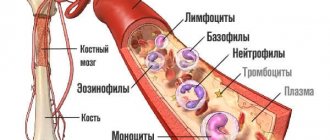When assessing the result of a blood test, doctors pay attention to the level of lymphocytes. Its change may indicate the development of infectious diseases, endocrine pathologies, allergic reactions and other health problems. You can understand whether there are any violations if you find out what the norm of lymphocytes is in children. It is important to check whether the obtained indicators correspond to the established norm.
What are lymphocytes?
Lymphocytes are a type of leukocyte. Depending on the morphological structure, it is customary to distinguish large (natural killer) and small cells (T- and B-lymphocytes).
It’s not for nothing that they say that lymphocytes are the guardians at the gates of health. This statement is based on the role of lymphocytes in the human body - protection against pathogens. In addition, they are able to recognize and destroy mutant cancer cells in the human body.
A distinctive feature of lymphocytes is the ability to provide a person with 2 types of immunity: humoral and cellular. The first is realized through the synthesis of protein molecules (antibodies), which are characterized by high affinity for various pathogenic microorganisms. After direct interaction of antibodies with antigens of the pathogen, a stable complex is formed. As a result of such interaction, toxins (poisonous substances synthesized by pathogenic microorganisms) are neutralized or the process of reproduction of a foreign cell is stopped.
The second (cellular) immunity is based on the direct participation of lymphocytes in the process of destroying pathogens, as well as on the regulation of the work of all other types of leukocytes.
The answer to the question of what is the normal level of immune cells in the blood is presented in the table (the values are given for patients over 16 years of age).
| Leukocyte type | Normal content |
| Neutrophils | 45 – 70 % |
| Lymphocytes | 20 – 35 % |
| Monocytes | 3 – 10 % |
| Eosinophils | 1 – 5 % |
| Basophils | 0 – 2 % |
Decoding
Now let's go through each of these indicators and figure out what they mean.
HGB - hemoglobin - Hemoglobin
Hemoglobin is a protein that carries oxygen throughout the body and delivers it to the necessary tissues. If there is not enough of it, the cells begin to starve and a whole chain of symptoms develops: weakness, fatigue, dizziness, hair loss and brittle nails, snags in the corners of the lips and others. These are symptoms of anemia.
The hemoglobin molecule contains iron, and vitamin B12 and folic acid also play an important role in its formation. If there are not enough of them, hemoglobin synthesis is disrupted in the body and anemia develops.
There are also hereditary forms of anemia, but they occur much less frequently and deserve separate analysis.
Normal hemoglobin is 120-160 g/l for women and 130-170 g/l for men. You need to understand that in each specific case the standards depend on the laboratory. Therefore, you need to look at the reference values of the laboratory in which you took the test.
Elevated hemoglobin numbers most often occur due to blood thickening, if a person sweats excessively during the heat, or takes diuretics. Climbers and people who often go to the mountains may have even higher hemoglobin - this is a compensatory reaction to a lack of oxygen. Hemoglobin can also increase due to diseases of the respiratory system - when the lungs work poorly and the body constantly lacks oxygen. Each specific case needs to be examined separately.
A decrease in hemoglobin is a sign of anemia. The next step is to figure out which one.
RBC - red blood cells - Erythrocytes
Erythrocytes are red blood cells that transport hemoglobin and are responsible for the metabolic processes of tissues and organs. It is hemoglobin, or rather its iron, that colors these cells red.
What is the purpose of the research?
A referral for testing can be written by a doctor - pediatrician, surgeon, infectious disease specialist or hematologist. The norm of lymphocytes in the blood of children is determined for the purpose of:
- diagnosing the presence of infectious diseases;
- differential diagnosis of viral and bacterial infections;
- determining the degree of immunity, which reflects the body’s ability to resist infectious agents;
- diagnosing the presence of helminth infestation;
- establishing the severity of an allergic reaction;
- early detection of side effects from taking medications;
- detection of immunodeficiency conditions;
- primary differential diagnosis of leukemia (bleeding) and determining the effectiveness of the chosen treatment tactics.
The norm of lymphocytes in the blood of a child
Important: it is prohibited to independently establish a diagnosis and choose treatment methods.
Such tactics can lead to a delay in the appointment of effective therapies and, as a result, a deterioration in health. When making a final diagnosis, the doctor takes into account various methods of laboratory and instrumental examination of the patient.
The norm of lymphocytes (reference values) in children is collected in the table by age.
| Age | Norm, *109 / l |
| Up to 12 months | 2 – 11,5 |
| From 1 to 2 years | 2,5 – 9,8 |
| From 2 to 4 years | 2 – 8,5 |
| From 3 to 4 years | 2 — 8 |
| From 4 to 6 years | 1,3 – 7,5 |
| From 6 to 8 years | 1,5 — 7 |
| From 8 to 10 years | 1,5 – 6,8 |
| From 10 to 15 years | 1,3 – 5,5 |
| Over 15 years old | 1 – 5 |
It is important to remember that the physiological norm is individual for each person. A slight excess of standard values has no diagnostic value and can be caused by a number of reasons (improper preparation, violation of analysis technology, or errors at the preanalytical stage). In this case, a repeat study is indicated after 3-5 days.
More on the topic “How to decipher a blood test. Leukocyte norm”:
Temperature for 5 days and normal blood test
For 5 days the temperature stays at 38, sore throat, lethargy. We took a test today, ESR is 4, only monocytes are elevated, 13 with a maximum of 9. Not our test?
ESR in blood test is 40!!!
I recently had a general blood test. everything is normal, but the ESR is 40, while the norm is 12-15 on average. I don't feel bad at all. A month ago I went on vacation, I had a fever there and then an allergy to the sun appeared. could this be the reason? because I read that this happens after an illness. I’m going to the doctor on Saturday, but I’ve already read horror stories on the Internet and I’m already afraid.. maybe someone has encountered something similar?
high ESR
My daughter has a high ESR of 40, all other indicators are normal, urine too, she has nothing to complain about, what could this be connected with? The only thing we complain about is a slight diathesis (apparently we ate too much sweets) and the distant tooth 6 is growing and the gums in that place are very inflamed. We will see the doctor only in 2 days.
Lymphocytes in the blood 55
We have been treating sinusitis for a month now. Donated blood. The ENT says an increased lymphocyte count - 55. I ran home and looked up all the information about the norms on the Internet. It seems like 55 is the norm at our age. What about ENT? Maybe someone here knows? I have terrible guesses. Don't leave moms... I'll go crazy.
General blood analysis.
Girls...What is ESR? and why do leukocytes increase? When the norm is 4.0-9.0, my leukocytes are 10.5, and my ESR is 48 when the norm is 2-15. What is the threat? who can tell? Otherwise, see the doctor only on Monday...
Blood test of a 2-year-old child.
Look at the blood test of a two-year-old child. Neutrophils - 24.5 (normal 33-61) Lymphocytes -62.2 (normal 33-55) Eosinophils - 4.4 - normal Platelets - 329 - normal Monocytes - 8.7 - normal Basophils - 0.2 - normal ESR - 14(norm up to 10)
What do you think?
ESR 34 is a lot
Yesterday we took a blood test and showed an ESR of 34, the doctor said that this was too much and said that we couldn’t do without antibiotics. I prescribed Augmentin, but my daughter seems to be better since yesterday, even the pace is not there, only the snot is green sometimes and she coughs occasionally. Maybe the doctor is playing it safe and you can do without antibiotics.
Blood test... Tell me!
I was very alarmed by the increased level of lymphocytes. The doctors say that this is normal... I looked at the child’s chart and they were elevated in all blood tests: 53,63,68. And in all previous blood tests, the level of segmented neutrophils was reduced 24-26 (with the norm being 47-72), once the level of leukocytes was increased. Doctors always said that the tests were normal. It is really normal when leukocytes are elevated and segmented neutrophils are decreased..
Help! Increased leukocytes in the blood during vomiting.
My 4 year old son has been vomiting all morning today. We got scared and went by ambulance to the hospital. They took a clinical blood test and the leukocytes were elevated to 13 thousand units. at a rate of up to 10 thousand. They force me to take the antibiotic Augumentin. Is such an increase in leukocytes an unconditional signal for prescribing antibiotics? Do white blood cells increase during viral infections?
What is the norm for leukocytes?...
Girls, where can I see the norm for leukocytes?...My 5-month-old son had his blood donated at the clinic - it turned out to be 11.2 (10.9 degrees/l). As I understand, this is a lot - they said on the form the norm is from 4.0 to 9.0. They already retook the test at Invitro - there it is again 11.2, and the reference values are from 6.0 to 17.5. But Invitro, of course, does not provide the norm for children. Question: where can I get the norm for children?

